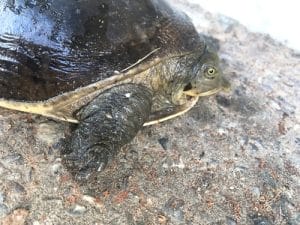Lissemys punctata (Indian Flapshell Turtle)
Home > Turtle Database > Lissemys punctata (Indian Flapshell Turtle)
Lissemys punctata, commonly known as the Indian flapshell turtle, is a softshell turtle native to South Asia. Its unique adaptation includes hinged flaps on the plastron, which help protect its limbs and head when retracted.
Native To These Regions
Andhra Pradesh (India), Assam (India), Bangladesh, Bihar (India), Chhattisgarh (India), Gujarat (India), Haryana (India), Jharkhand (India), Karnataka (India), Kerala (India), Madhya Pradesh (India), Maharashtra (India), Nepal, Odisha (India), Pakistan, Punjab (India), Rajasthan (India), Sri Lanka, Tamil Nadu (India), Telangana (India), Uttar Pradesh (India), West Bengal (India)Native Turtle Species Map – Find Turtles by Region
Scientific Classification
- Kingdom: Animalia
- Phylum: Chordata
- Class: Reptilia
- Order: Testudines
- Family: Trionychidae
- Genus: Lissemys
- Species: Lissemys punctata
Common Names
Indian flapshell turtle
Flap-shelled turtle
This Hilarious Turtle Book Might Know Your Pet Better Than You Do
Let’s be real—most turtle care guides feel like reading a textbook written by a sleep-deprived zookeeper.
This one’s not that.
Told from the snarky point of view of a grumpy, judgmental turtle, 21 Turtle Truths You’ll Never Read in a Care Guide is packed with sarcasm, sass, and surprisingly useful insights.
And hey—you don’t have to commit to the whole thing just yet.
Grab 2 free truths from the ebook and get a taste of what your turtle really thinks about your setup, your food choices, and that weird plastic palm tree.
It’s funny, it’s honest, and if you’ve ever owned a turtle who glares at you like you’re the problem—you’ll feel seen.
Identification
Description
The Indian flapshell turtle has an olive-green to brown carapace with a smooth and leathery texture. It often displays yellow patterns or spots. The plastron is light-colored with flexible flaps. Its head is broad and features a short snout.
Sexual Dimorphism
Males are smaller than females and have longer, thicker tails. Females are larger to accommodate egg-laying.
Check more turtles from the Lissemys genus
Native Origin and Distribution
Geographical Range
This species is found across India, Pakistan, Sri Lanka, Bangladesh, Nepal, and Myanmar. It thrives in both plains and foothills.
Preferred Habitat
Indian flapshell turtles inhabit freshwater environments like ponds, lakes, rivers, and marshes. They prefer shallow, slow-moving waters with abundant vegetation and soft, muddy bottoms.
Behavior
Feeding Habits
These turtles are omnivorous, consuming aquatic vegetation, small fish, insects, and carrion.
Predators
Natural predators include large birds, crocodiles, and humans, who hunt them for their meat and shells.
Reproduction
Breeding Season
Breeding typically occurs during the monsoon season, from June to October.
Reproductive Method
Females lay 6–15 eggs in sandy riverbanks or soft soil, and the incubation period ranges from 60 to 90 days.
Conservation
Extinction Status
The Indian flapshell turtle is listed as Vulnerable by the IUCN.
Threats
Overexploitation for meat, habitat destruction, and pollution are the main threats.
Conservation Measures
Protected areas, legal regulations, and awareness campaigns aim to conserve this species.
Economic Importance
These turtles are often harvested for local consumption and traditional medicine. However, they also contribute to controlling pests and maintaining the aquatic ecosystem’s health.
Interesting Facts
- The hinged flaps on the plastron are a rare feature among turtles.
- They can survive in extreme drought by burrowing into the mud and entering a state of aestivation.
- Their ability to tolerate low oxygen levels allows them to thrive in stagnant or polluted water.

About Author
Muntaseer Rahman started keeping pet turtles back in 2013. He also owns the largest Turtle & Tortoise Facebook community in Bangladesh. These days he is mostly active on Facebook.














